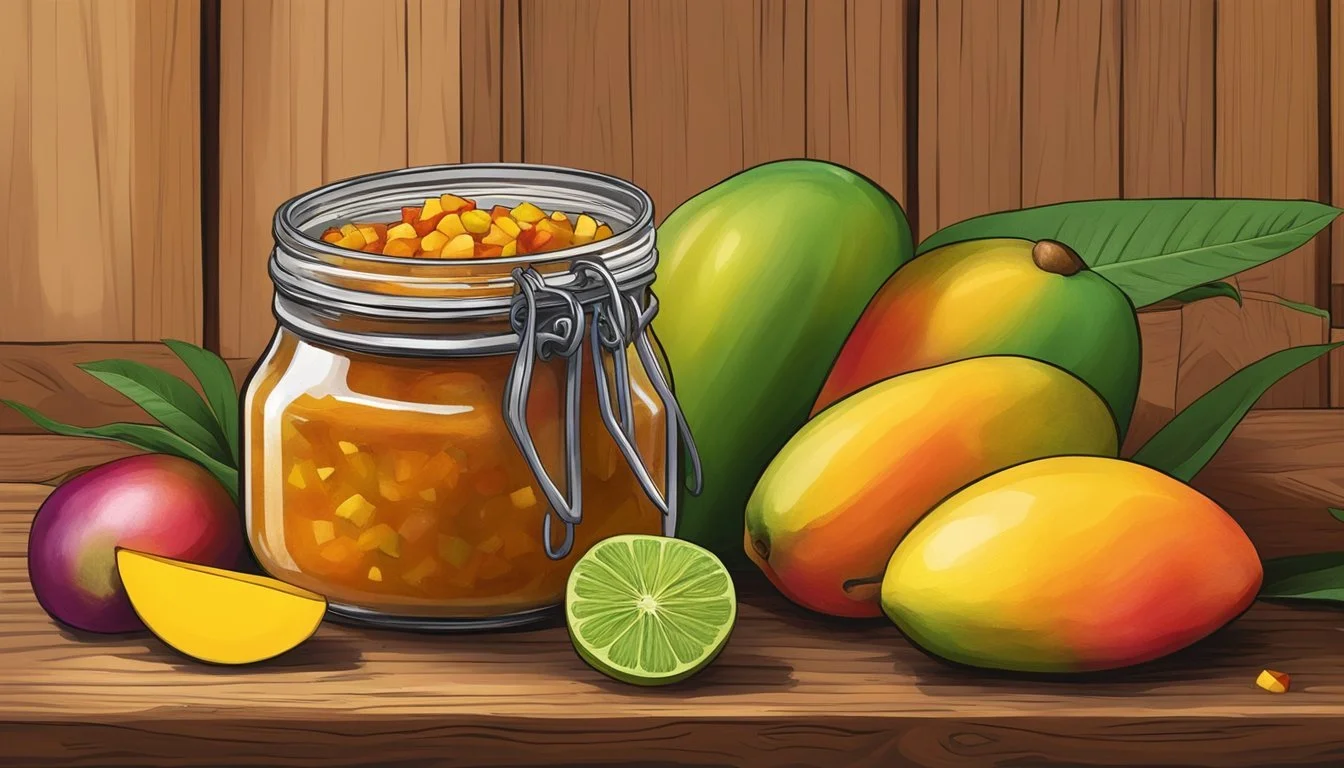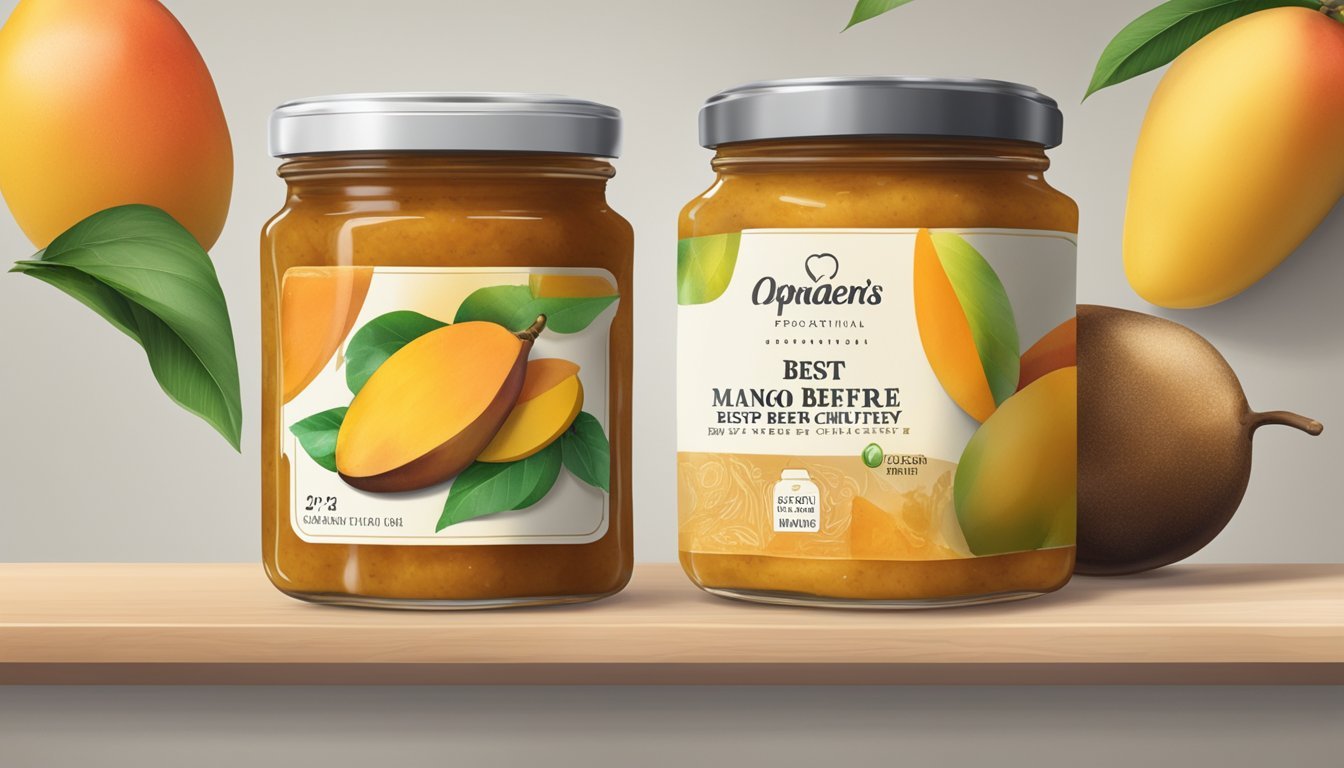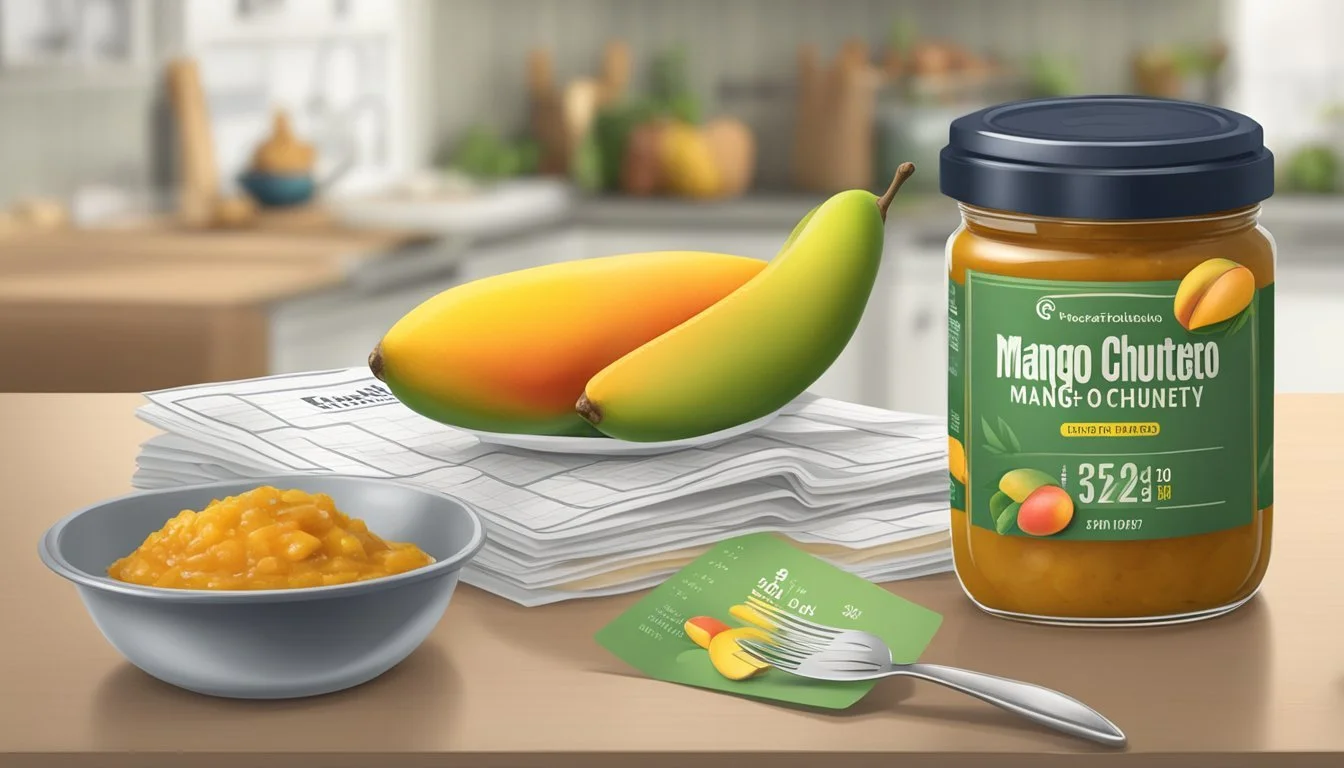How Long Does Mango Chutney Last?
Shelf Life and Storage Tips
Mango chutney (how long does mango chutney last?) is a flavorful condiment that enhances meals with its sweet and spicy taste profile. It is made from ripe mangoes, combined with ingredients like vinegar, sugar, and spices, which not only contribute to its unique flavor but also act as preservatives. The shelf life of homemade mango chutney can vary depending on storage conditions, with properly canned chutney lasting for up to a year and frozen variants potentially preserving their quality for six months.
Once opened, the shelf life of mango chutney is generally shorter. Refrigeration is key to maintaining its taste and preventing spoilage, with most chutneys remaining good for 2 to 3 months when stored in the fridge. Specific types of mango chutney may have differing advice on storage, especially if they contain ingredients that can spoil more quickly, such as dairy.
For unopened chutney, the best quality is often retained for about 2 years when it is stored in a cool, dark place. It's important to pay close attention to the signs of spoilage, such as an off smell, discoloration, or any signs of mold, to ensure the condiment is still safe for consumption.
Mango Chutney Fundamentals
Within the realm of condiments, mango chutney holds a particular allure due to its intricate flavor profile and preservation method. This section will outline the essence of what chutney is and the crucial ingredients that define its character.
Defining Chutney
Chutney is a pungent condiment that originates from Indian cuisine. It encompasses an array of textures and flavors, typically combining sweet, tart, and spicy elements. This condiment is traditionally prepared by simmering down fruit with sugar, vinegar, and a medley of spices. Mango chutney, in particular, highlights mango as the primary fruit, harnessing its rich, tropical taste, which is preserved and enhanced through this cooking process.
Key Ingredients
The staple ingredients in mango chutney include:
Mangoes: Ripe mangoes are the foundation, lending the chutney its characteristic sweetness and body.
Vinegar: Acts as a preserving agent, giving chutney a sharp tanginess that cuts through the sweetness.
Sugar: Balances the acidity of the vinegar and helps in the preservation process.
Spices: Common choices are ginger, garlic, coriander, and various others, introducing complexity and heat.
A usual assortment for mango chutney might look like:
Mangoes: 2 cups, chopped
Vinegar: 1/2 cup
Sugar: 3/4 cup
Ginger: 1 tablespoon, grated
Garlic: 2 cloves, minced
Coriander: 1 teaspoon, ground
These components are cooked together until they reach a jam-like consistency, wherein mango remains the star, complemented by the robust flavors of spices such as ginger and garlic. The role of coriander is often to introduce a hint of citrusy depth, which marries well with the sweetness of the fruit and the tang of vinegar.
Benefits and Culinary Uses
Mango chutney is a vibrant condiment, valued not just for its longevity but also for its versatility and the unique flavor it lends to various dishes across different cuisines.
Flavor Profile and Pairings
Mango chutney possesses a sweet and tangy flavor profile that can complement a variety of foods. It traditionally pairs well with Indian appetizers like samosas and poppadoms. The chutney’s sweet notes make it an excellent pairing with sharp cheeses, grilled meats, (What wine goes well with grilled meats?) and chicken, offering a burst of flavor that enhances the overall taste of these dishes.
Recipes: Incorporating mango chutney in marinades or as a glaze adds a fruity, tangy twist to the recipes.
Serve: To elevate a simple sandwich or wrap, it can be spread as a condiment for a touch of sweetness.
Versatility in Cuisine
The versatility of mango chutney allows it to be used in various culinary applications. It's often used as a condiment in:
Indian Cuisine: A staple alongside curries and with naan bread.
Fusion Cuisine: Its use as a base for salsa or as a dip for appetizers merges traditional and modern flavors.
Western Cuisine: It enhances the taste of grilled meats, acting as a balance for savory notes.
Storage Guidelines
Proper storage of mango chutney is essential in preserving its freshness and flavor. The shelf life and storage methods differ significantly between unopened commercial chutney and homemade chutney once it is opened.
Unopened Chutney Shelf Life
Unopened commercial mango chutney usually has a long shelf life due to the preservatives it contains. It can be stored in a dark, cool place at room temperature and will generally remain at best quality for about 2 years. However, the absence of preservatives in homemade chutney means it may have a shorter shelf life.
After Opening Storage
Once opened, mango chutney should be stored in an airtight container in the refrigerator to preserve its quality. Opened chutney that's continuously refrigerated can last up to one month. Always use clean utensils when handling to prevent contamination and ensure the chutney's longevity.
Freezing Homemade Chutney
Freezing homemade mango chutney can extend its shelf life. It should be placed in an airtight container or heavy-duty freezer bags before storing in the freezer. Properly stored, homemade mango chutney can last for up to 6 months in the freezer. Remember to label and date the containers to keep track of how long they have been stored.
Signs of Deterioration
When assessing mango chutney for signs of spoilage, one should look for any deviation in appearance, texture, and aroma, as these can indicate that the chutney's quality has degraded.
Visual and Textural Changes
Color: A visual clue of spoilage is a change in color. Mango chutney that has deteriorated may display darkening or discoloration that differs markedly from its original golden to deep orange hue.
Texture: The texture of the chutney should be consistent throughout. If one notices the presence of mold or a slimy or overly thickened consistency, these are indications that the chutney has gone bad.
Smell and Flavor Alteration
Smell: A fresh mango chutney should have a sweet and tangy aroma with subtle spice undertones. An off or sour smell is a clear sign that the chutney is no longer safe for consumption.
Flavor: While it is not recommended to taste a chutney that exhibits any visual or olfactory signs of spoilage, a significant alteration from its original flavor profile often accompanies a spoiled product.
Safety and Preservation Techniques
Ensuring the longevity and safety of mango chutney hinges on understanding the fundamentals of expiration and employing proper handling and preparation methods. This section delineates the key practices for preserving mango chutney effectively.
Understanding Expiration
Expiration of mango chutney can vary based on factors like preservatives and storage conditions. A chutney without artificial preservatives may rely on natural preservatives, such as salt and sugar, to inhibit bacterial growth and extend shelf life. One should note the expiration date on commercially prepared chutney as it indicates when the product may start to lose its optimum quality.
Commercially produced chutney typically lasts longer than homemade versions due to these added preservatives.
The pH level of the chutney is crucial; a lower pH means higher acidity, which helps in preserving the chutney for an extended period.
Proper Handling and Preparation
Proper handling and preparation are paramount for the preservation of mango chutney. From cooking to consumption, each step should minimize contamination and delay spoilage.
Sterilized jars are essential; one must sterilise jars to ensure an aseptic environment for storage, thus, preventing the introduction of microbes.
Using a clean spoon each time the chutney is served can drastically reduce the risk of contamination.
Table: Recommended Preservation Methods For Homemade Mango Chutney
Method Description Clean Utensils Always use clean equipment to prevent bacterial contamination. Sterilization Use jars that have been properly sterilized to eliminate microbial presence. Refrigeration Keep chutney refrigerated to slow down the degradation process. Sealing Techniques Ensure airtight sealing to protect against air and moisture. Check pH Maintain a high acidity level, typically a low pH, to naturally preserve the chutney.
By following these techniques, one can optimize the shelf life of mango chutney while ensuring it remains safe to consume.
Nutritional Profile and Health Considerations
Mango chutney offers a balance of sweet and tangy flavors and brings a notable nutritional profile to the table. It is key for consumers to understand both its caloric content and the potential health benefits or dietary restrictions associated with its ingredients.
Caloric Content
Mango chutney typically contains a moderate amount of calories due to its sugar content. In every tablespoon of mango chutney, one can expect:
Calories: Approximately 20-30 calories
This is primarily due to the natural sugars from the mangoes and any added sugars for taste.
Health Benefits and Restrictions
Health Benefits:
Vitamin A: Mango, the core ingredient, is rich in vitamin A, which supports eye health and the immune system.
Digestive Health: The fiber in mangoes can aid in digestion.
Antioxidants: Mangoes contain antioxidants that protect against free radicals.
Dietary Restrictions:
Sugar Content: Individuals monitoring their sugar intake should be conscious of the sugar levels in chutney.
Allergens: Those with allergies should check for allergens like nuts or dairy that might be present in certain chutney recipes.
Sodium: Some chutneys may have high sodium levels due to preservation methods, which could be a concern for those with blood pressure issues.
Consumers should always consider these factors when incorporating mango chutney into their diet.
Homemade Chutney Making
Creating homemade chutney demands attention to ingredient quality and a methodical approach to preparation and cooking. Ensuring a balance of flavors and proper preservation techniques are paramount.
Selecting Quality Ingredients
In crafting homemade chutney, one should begin by choosing high-quality, fresh ingredients. Ripe mangoes are essential for a rich flavor base, while the right combination of acidity and spices will ensure both taste and preservation.
Fruits: Fresh, ripe mangoes
Acidity: Vinegar (provides preservation)
Sweeteners: Sugar (balances acidity)
Spices: A mix that may include mustard, cloves, cinnamon, cumin seeds, coriander seeds, nigella seeds, and cardamom
Step-by-Step Chutney Recipe
The preparation of chutney is a straightforward process, but it requires careful attention to each step. Here's a simplified yet precise chutney recipe:
Prep Time: 15 minutes
Cook Time: 50 minutes
Total Time: 1 hour 5 minutes
First, one should prepare the mangoes by peeling and cutting them into small, even pieces. Next, gather all the spices – cumin, coriander, mustard, cloves, cumin seeds, coriander seeds, nigella seeds, cinnamon, cardamom – and lightly toast them if required to enhance their flavors.
The cooking process starts with sautéing the base ingredients, such as onion, garlic, and ginger if used. Following that, one adds the diced mangoes, toasted spices, sugar, and vinegar. The mixture should then be brought to a boil and left to simmer, uncovered, to allow for thickening and the melding of flavors. Cooking times may vary, with an approximate range of 45 minutes to 1 hour for the chutney to reach the desired consistency.
Homemade chutney's longevity is a direct result of maintaining the balance between acidity, sugar, and the sterilization of jars used for storing the final product.
Additional Tips and Tricks
When managing the shelf life of mango chutney, a versatile condiment known for its sweet and tangy flavors, one should not overlook certain tips and tricks that can enhance its longevity. Here is a distillation of such guidance:
Storing in a Cool, Dark Place:
Once opened, it's imperative to store mango chutney in a cool, dark place. Exposing it to heat or direct sunlight can compromise its quality.
Air-tight Containers:
Use air-tight containers to preserve the flavours and prevent contamination. This practice helps in maintaining the condiment's freshness for longer periods.
Portioning Out Servings:
To minimize exposure to air and potential spoilage, it's beneficial to portion out servings:
Size Utility Small Ideal for single uses Medium Suitable for family meals Large Efficient for gatherings or special events
Avoiding Cross-Contamination:
Always use a clean utensil for serving to prevent introducing bacteria that could lead to faster spoilage.
Hot vs. Cool:
Unlike hot sauces like sriracha, mango chutney does not contain capsaicin, which acts as a preservative, so it is best kept refrigerated after opening.
Do Not Dilute:
Diluting the condiment with water or other liquids can alter its consistency and introduce bacteria, leading to a shorter shelf life.
Observing Changes in Consistency and Taste:
If the chutney appears darker than usual, develops a foul odor, or the taste has significantly altered, it's an indicator that it has gone bad and should no longer be used.
Conclusion
Mango chutney, with its delightful blend of sweet and tangy flavors, can be a delectable addition to various dishes. Its long shelf life is a significant advantage, making it a convenient preserve to have on hand.
Upon opening, it should be refrigerated to maintain quality and flavor. Ideally, one should consume it within 2 to 3 months to enjoy its best taste, although it may be safe to consume beyond this period if it shows no signs of spoilage. Any change in color, smell, or taste indicates that the chutney should not be consumed.
To preserve its shelf life, here are key storage recommendations:
Keep it in a cool and dry place before opening.
Store between 40°F (4°C) and 50°F (10°C) post-opening.
Avoid light exposure to preserve flavor and prevent spoilage.
When ready to serve, always use a clean utensil to avoid contamination. Consumers' dedication to proper storage methods will ensure the chutney remains a flavorful accompaniment for an extended period.










